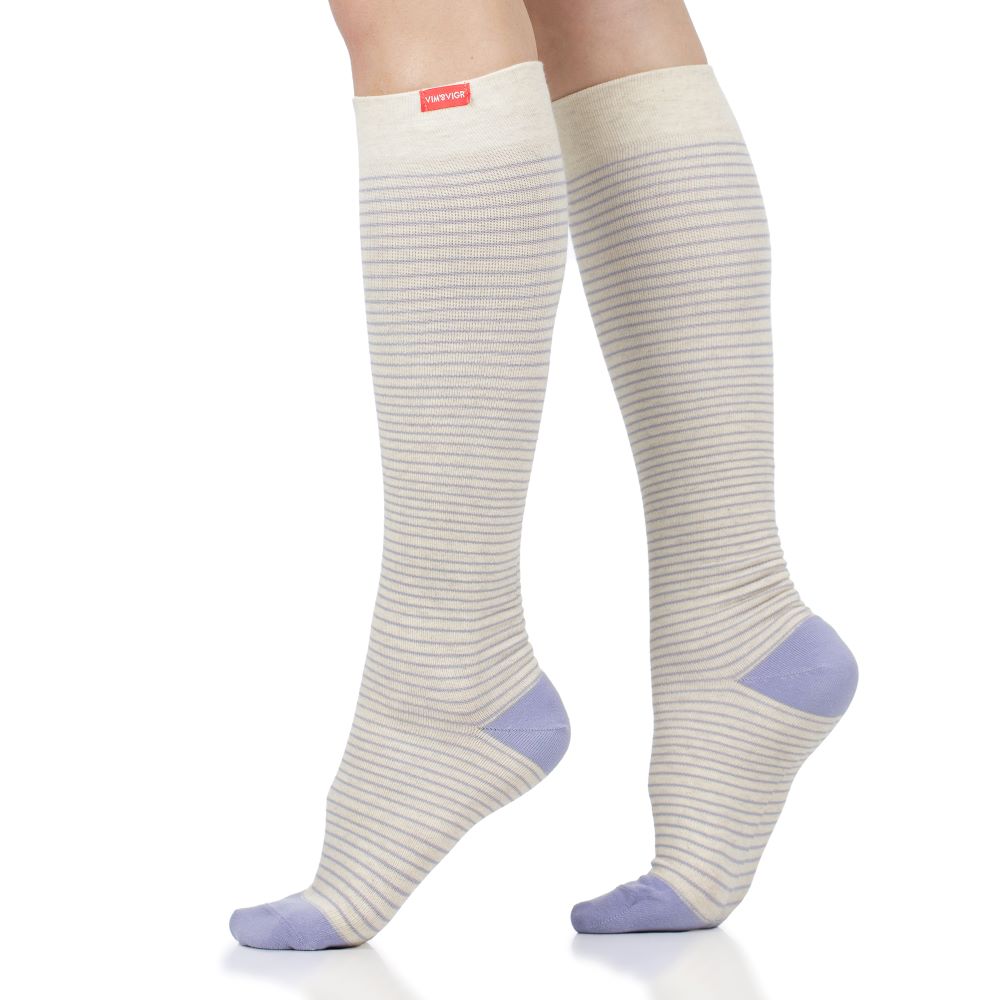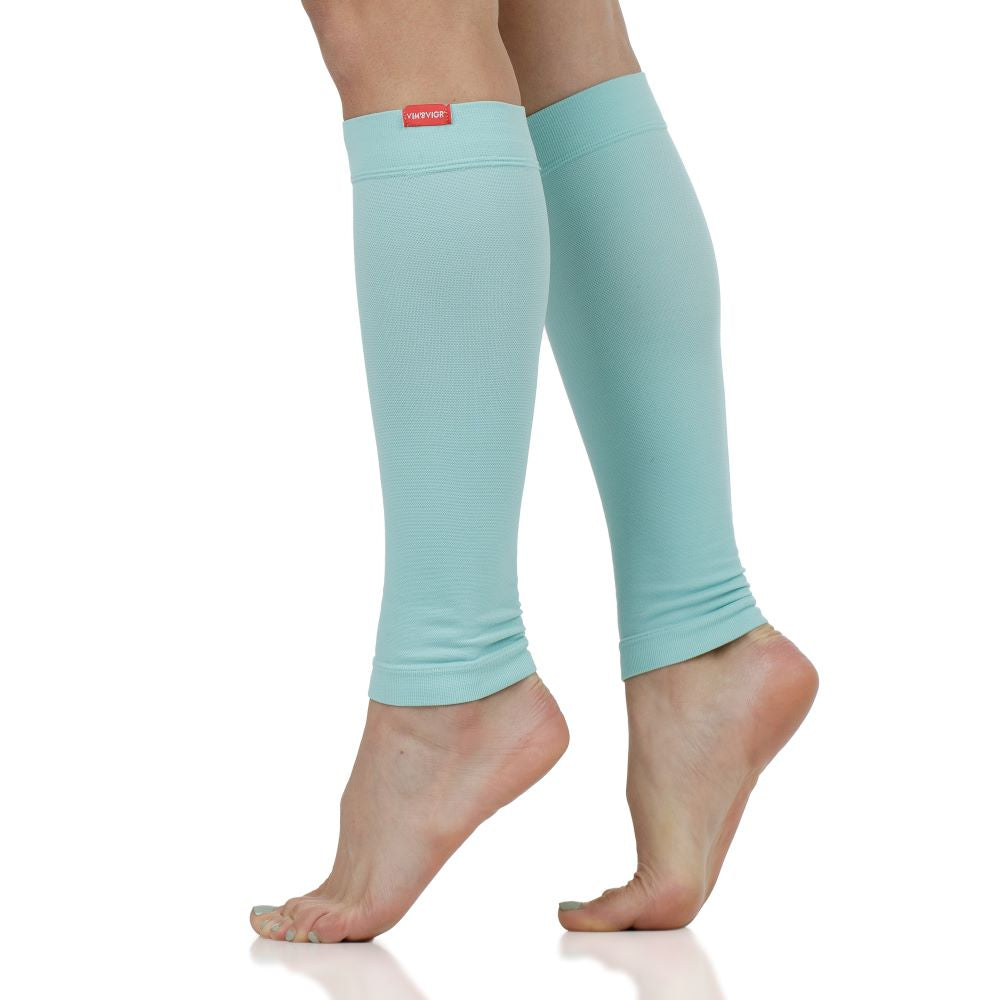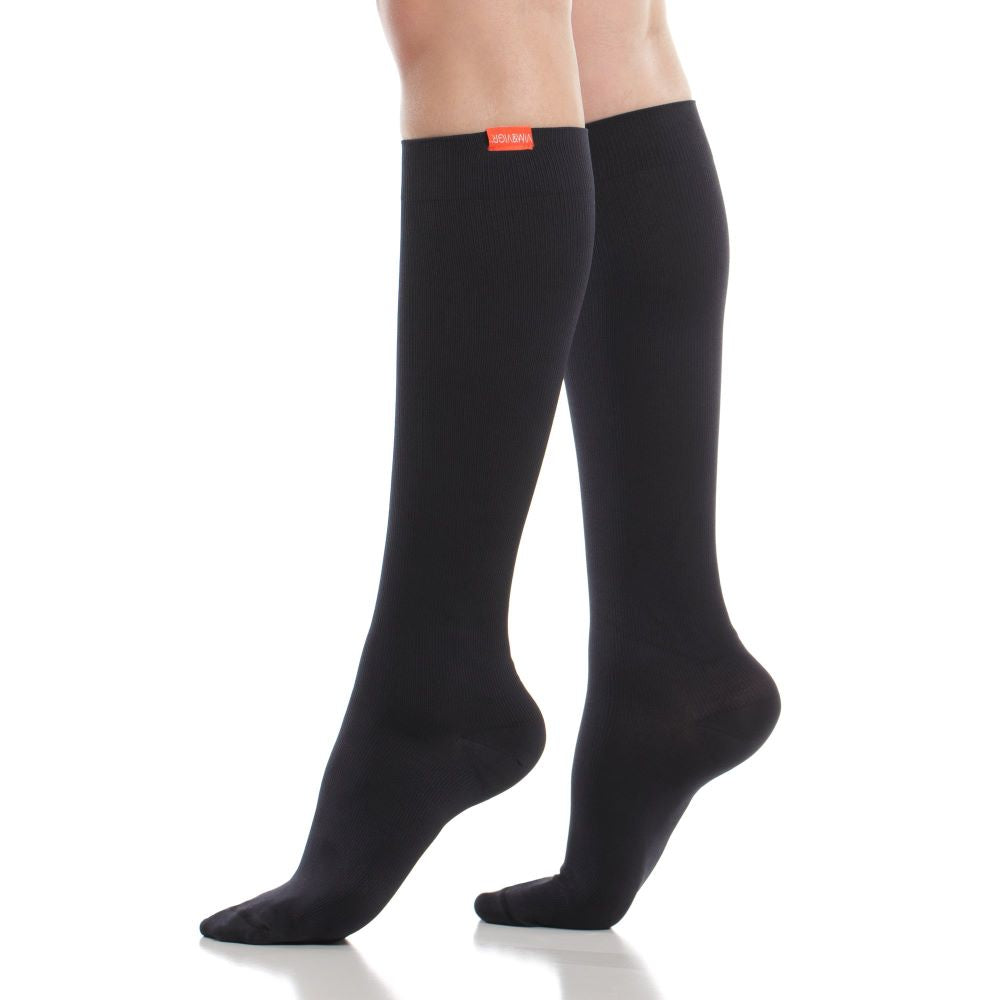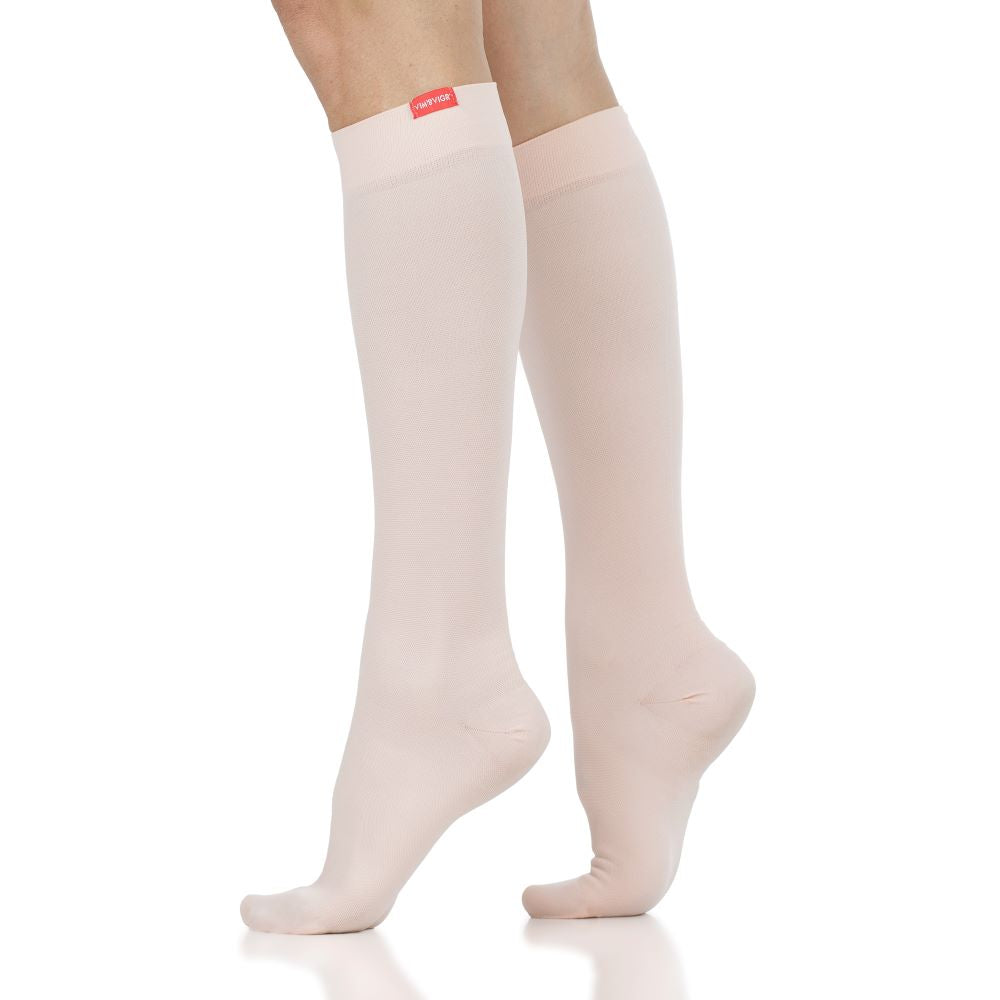Do Compression Socks Help with Shin Splints?
Shin splints are a common injury among runners and athletes in general. They can also often affect walkers and hikers. And, although shin splints often heal naturally, on their own, they can become quite uncomfortable.
Do compression socks help with shin splints, either as prevention or to ease pain and reduce healing time? They boost your blood circulation, reduce swelling, and are great for vein support, so they can definitely be a useful tool against shin splints, depending on your individual situation.
Read on to find out more about shin splints, who’s at risk of getting them and how they manifest, and what benefits you can expect from wearing compression socks when you suffer from shin splints.

Can Compression Socks Help with Shin Splints?
The role of compression socks in injury recovery has been well documented. Thanks to the gentle massage applied to your lower legs, blood flows better from the legs into the circulatory system, avoiding swelling and “heavy legs” feelings. Reduced inflammation and swelling are therefore two key benefits of wearing compression socks for runners or anyone who’s on their feet a lot.
Additionally, compression socks help prevent the formation of varicose veins and blood clots as they ensure that your peripheral blood circulation is optimal and there’s no fluid build-up in the lower legs, ankles and feet.
When it comes to shin splints, these manifest themselves as pain or tenderness along or just behind the tibia - the large bone in the lower leg. Athletes typically feel pain on the front of the shin either while running or when touching the area. The usual recovery advice is to apply ice to the area and ensure you wear adequate running shoes to avoid getting shin pain in the future.
This is where compression socks come in. Firstly, they help reduce inflammation and pain around the tibia, speeding up your recovery from shin splints. Secondly, wearing compression sleeves or socks during exercise may provide additional vein and muscle support (thanks to the tight fit) that can prove beneficial in preventing shin splints from occurring. We’ll take a look at both actions in more detail below.
What Are Shin Splints and What Causes Them?
Before discussing the role of garments such as calf compression sleeves, compression socks etc. in preventing and helping recover from shin splints, let’s have a look at what they really are and why you get them.
Shin splints is the term used to describe pain and tenderness along the front of the lower leg - i.e. the tibia (the largest bone). In medical terms, this is known as medial tibial stress syndrome.
As a common injury from exercise, shin splints are caused by overuse. This can mean ramping up your training significantly in a short time, without giving your body time to adapt to the intensity or volume. It can also be the result of inflammation and fatigue from a big bout of effort (for example, running a marathon).
Shin splints are not a stress fracture, but they can develop into one. If you continue to run or play sports like basketball or tennis (involving a lot of running and jumping), without allowing your legs to heal, then you could progress into a stress fracture. Occurring on a relatively large bone, it can take a long time to recover from a stress fracture. You may also need to wear crutches or a walking boot.
People at High Risk for Shin Splints
Shin splints occur when athletes in general place too much pressure too quickly on their lower legs. This means running a lot more very quickly, without adequate rest, or doing a multi-day hike without prior training, or playing a lot of basketball where you’re jumping and landing forcefully. Any of these are examples of overuse.
Doctors believe that the categories of people most at risk for shin splints are:
- Runners, especially beginners who are not accustomed to regular exercise;
- Athletes suddenly increasing the volume or intensity of their workouts (or both);
- People running on concrete are more at risk because they land on a harder surface and there is less variation in their motion pattern;
- People with either flat feet or high arches can develop shin splints more rapidly than others;
- Military trainees;
- People suffering from osteoporosis or osteopenia, whose bones are generally weaker.
It’s important to note that the stress caused to the shin bone does not only come from the landing or running movement. It also refers to pressure placed on the connective tissue that attaches the calf muscles to the bone, so you could develop shin splints by placing a lot of pressure on your calves, for example.

Symptoms of Shin Splints
How do shin splints feel? Beyond the pain you may experience on the front of your lower leg when running, there are a few symptoms that are also associated with this condition:
- Pain on either side of the shin bone;
- Pain along the inside of the lower leg (one or both legs);
- Tenderness or soreness when touching the front of your lower leg or the inside;
- Slight swelling of the lower leg;
- Feet may go numb or weak.
We’ve explained that shin splints cover overuse of the connective tissue around your lower leg, as well as increased pressure on the calf muscles. So, along with your shin splints, you may experience discomfort in the calves or the Achilles tendon.
The Benefits of Compression Socks for Shin Splints
Luckily, there’s more than just rest to help you recover from shin splints. Thanks to the gentle massage and blood flow boost provided by compression socks or calf sleeves, you can speed up your recovery process and lower the discomfort a bit quicker.
Compression socks are great partners for anyone engaging in physical activity. They help in a multitude of ways:
- They promote blood circulation to the lower legs, helping muscles recover quicker after exercise;
- Through better blood flow, they also prevent swelling and help reduce the build-up of fluid around your ankles;
- Improved circulation helps reduce inflammation and soreness;
- The massaging action contributes to pain relief;
- Through pressure and support to the calf muscles and lower legs overall, compression garments can help prevent some overuse injuries like shin splints by reducing the pressure from running or long-distance hiking.

How to Wear Compression Socks to Prevent Shin Splints
To make the most of your compression socks against shin splints, you need to make sure you’re wearing the right size and compression levels for you. Additionally, we recommend considering the materials the socks are made of, to align to your activity levels and the weather conditions.
Compression socks have to be tight, without becoming restrictive. This is why sizing is really important. Ensure you follow the steps in this sizing guide to measure your legs and match against our catalog. We’d also recommend trying out compression sleeves and socks in store.
In terms of compression levels, we offer the following range:
- 15-20 mmHg - light compression, ideal for everyday wear or for your runs and workouts;
- 20-30 mmHg - moderate compression, better for long days out or long flights where you don’t get to move around too much;
- 30-40 mmHg - high or medical grade compression, usually prescribed by a doctor in recovery from injury or after surgery.
Finally, ensure you pick the right fabric for your socks. If you’re going to wear them all day and want to pair them with cute outfits, we recommend cotton as it’s versatile and we have such a wide range of styles. Go for Merino wool for a hike or running in the cold or wet weather, as they’ll be breathable and keep your feet dry. On hot summer days, Merino wool is lightweight and moisture wicking, or you could wear Nylon or moisture-wick Nylon for a pair of socks that keeps up with your physical activity levels.
Wearing Compression Socks for Shin Splint Recovery
If you’re already suffering from shin splints, you’ll be looking for a way to reduce pain and swelling. The best compression socks for this kind of situation are likely to be the moderate pressure levels (20-30 mmHg), which you can wear at night or after a hard workout.
If you’ve stopped running while you recover, we also recommend wearing cotton compression socks throughout the day (in lower compression levels, 15-20 mmHg). They go with any outfit and can provide a bit of extra support and TLC to your lower legs.
You can wear compression socks all day long, but you should probably start with a few hours until you’re used to them. Slowly increase the amount of time you wear your socks for, and don’t forget to also use an ice pack on your shins if they’re really sore.

What Are the Best Compression Socks for Shin Splints?
Preventing shin splints relies primarily on increasing your activity level slowly and progressively. You should also be careful to stretch and warm up properly before any run, as well as cool down and stretch afterwards.
In addition to these prevention tips, you can wear compression calf sleeves or socks during your runs to give your legs some extra support. The best shin splint preventing compression socks will fit you well, provide gentle pressure (but not restrict your range of motion), and be made of moisture-wicking, lightweight fabrics that feel comfortable during a run or workout.
When you’re recovering from shin splints, the best compression socks will be a little firmer on the leg, massaging the calf muscles and relieving tension and discomfort. As you’re resting from physical effort, we recommend wearing versatile cotton socks that can fit your style and any outfit.
Who Shouldn’t Wear Compression Socks for Shin Splints?
Compression socks are generally harmless and will suit most people without a serious medical condition that prevents them from wearing restrictive or compressive garments. However, there may be cases when compression socks are not the best option, even if you think they could help with your shin splints.
These include people with delicate skin, or skin that irritates easily - although you can look at Merino wool socks which are hypo-allergenic and gentle on the skin.
Another situation where we would recommend seeing a doctor rather than resorting to compression socks is when the condition is quite serious. Compression can only go so far as to help an actual stress fracture, and there may be some other scenarios in which you need to seek medical help.
These include:
- If you notice redness or warmth in one area of your vein on the leg;
- If you have persistent leg cramps in either or both legs;
- Swollen, hard veins;
- Loss of circulation or feeling tender for a long time in either one or both legs;
- Skin turning blue or purple.
Check out our extensive range of compression socks, calf sleeves and other compression garments to help you make the most of your running and stay healthy and fresh!



















Leave a comment